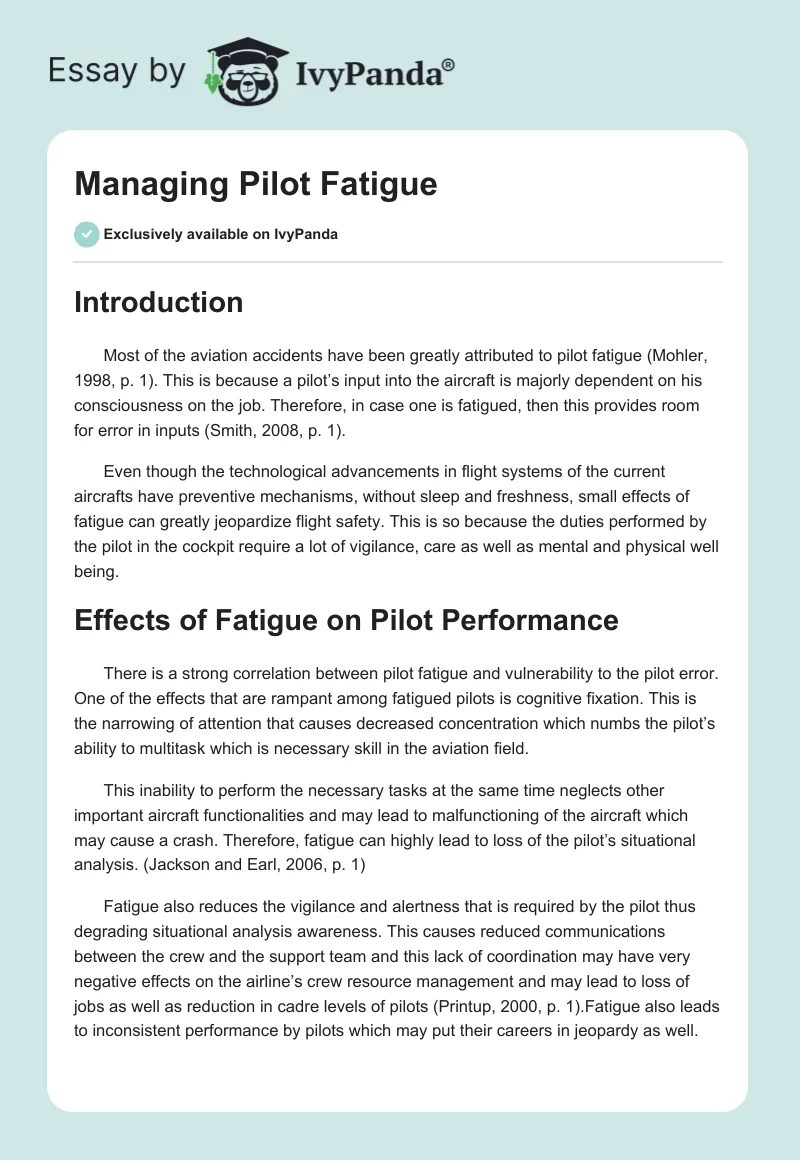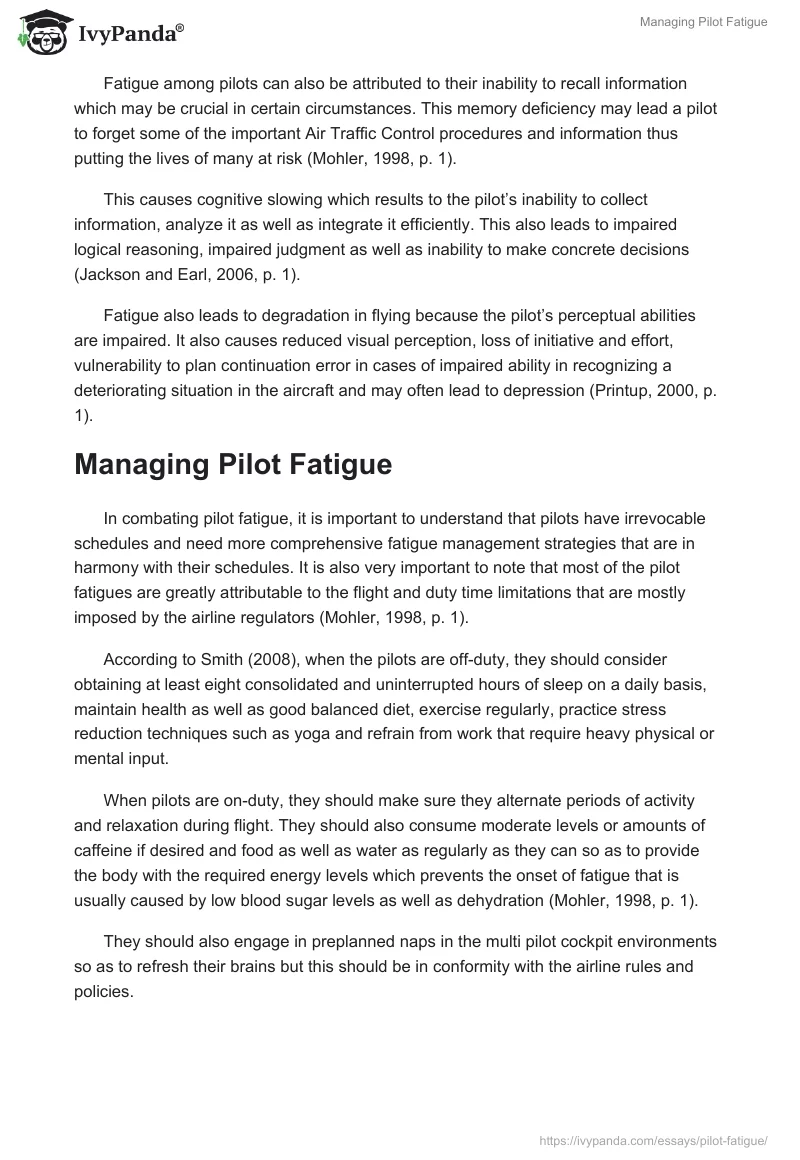Introduction
Most of the aviation accidents have been greatly attributed to pilot fatigue (Mohler, 1998, p. 1). This is because a pilot’s input into the aircraft is majorly dependent on his consciousness on the job. Therefore, in case one is fatigued, then this provides room for error in inputs (Smith, 2008, p. 1).
Even though the technological advancements in flight systems of the current aircrafts have preventive mechanisms, without sleep and freshness, small effects of fatigue can greatly jeopardize flight safety. This is so because the duties performed by the pilot in the cockpit require a lot of vigilance, care as well as mental and physical well being.
Effects of Fatigue on Pilot Performance
There is a strong correlation between pilot fatigue and vulnerability to the pilot error. One of the effects that are rampant among fatigued pilots is cognitive fixation. This is the narrowing of attention that causes decreased concentration which numbs the pilot’s ability to multitask which is necessary skill in the aviation field.
This inability to perform the necessary tasks at the same time neglects other important aircraft functionalities and may lead to malfunctioning of the aircraft which may cause a crash. Therefore, fatigue can highly lead to loss of the pilot’s situational analysis. (Jackson and Earl, 2006, p. 1)
Fatigue also reduces the vigilance and alertness that is required by the pilot thus degrading situational analysis awareness. This causes reduced communications between the crew and the support team and this lack of coordination may have very negative effects on the airline’s crew resource management and may lead to loss of jobs as well as reduction in cadre levels of pilots (Printup, 2000, p. 1).Fatigue also leads to inconsistent performance by pilots which may put their careers in jeopardy as well.
Fatigue among pilots can also be attributed to their inability to recall information which may be crucial in certain circumstances. This memory deficiency may lead a pilot to forget some of the important Air Traffic Control procedures and information thus putting the lives of many at risk (Mohler, 1998, p. 1).
This causes cognitive slowing which results to the pilot’s inability to collect information, analyze it as well as integrate it efficiently. This also leads to impaired logical reasoning, impaired judgment as well as inability to make concrete decisions (Jackson and Earl, 2006, p. 1).
Fatigue also leads to degradation in flying because the pilot’s perceptual abilities are impaired. It also causes reduced visual perception, loss of initiative and effort, vulnerability to plan continuation error in cases of impaired ability in recognizing a deteriorating situation in the aircraft and may often lead to depression (Printup, 2000, p. 1).
Managing Pilot Fatigue
In combating pilot fatigue, it is important to understand that pilots have irrevocable schedules and need more comprehensive fatigue management strategies that are in harmony with their schedules. It is also very important to note that most of the pilot fatigues are greatly attributable to the flight and duty time limitations that are mostly imposed by the airline regulators (Mohler, 1998, p. 1).
According to Smith (2008), when the pilots are off-duty, they should consider obtaining at least eight consolidated and uninterrupted hours of sleep on a daily basis, maintain health as well as good balanced diet, exercise regularly, practice stress reduction techniques such as yoga and refrain from work that require heavy physical or mental input.
When pilots are on-duty, they should make sure they alternate periods of activity and relaxation during flight. They should also consume moderate levels or amounts of caffeine if desired and food as well as water as regularly as they can so as to provide the body with the required energy levels which prevents the onset of fatigue that is usually caused by low blood sugar levels as well as dehydration (Mohler, 1998, p. 1).
They should also engage in preplanned naps in the multi pilot cockpit environments so as to refresh their brains but this should be in conformity with the airline rules and policies.
Conclusion
If a pilot is not in a position to avoid duty when is fatigued, Jackson and Earl (2006) suggests that one should eat high protein foods coupled with a lot of water for it temporarily holds fatigue at bay, caffeinated beverages though moderate levels help in enhancing alertness and most of all making conversations with other crew members, making rounds and stretching is therapeutic enough to edge-off fatigue.
But in a situation where a pilot may not feel confident in his ability to fly due to fatigue, regardless of the schedules, one should not fly. This is to avoid putting the lives of many people at jeopardy including the legacy or image of the company on the spot in the event of an accident (FAA, 2009, p. 1).
Reference List
Federal Aviation Administration (FAA). (2009). Fatigue in Aviation. Pilot Safety. Web.
Jackson, A. and Earl, L. (2006). Prevalence of fatigue among commercial pilots. Oxford Journals. Web.
Mohler, S. (1998). Pilot Fatigue Manageable, but Remains Insidious threat. Human Factors & Aviation Medicine: Vol. 45: 1. Web.
Printup, M. (2000). The Effects of Fatigue on Performance and Safety. Airline Safety. Web.
Smith, B. L. (2008). Pilot Fatigue Detection Using Aircraft State Variables. West Virginia University: College of Engineering and Mineral Resources. Web.


